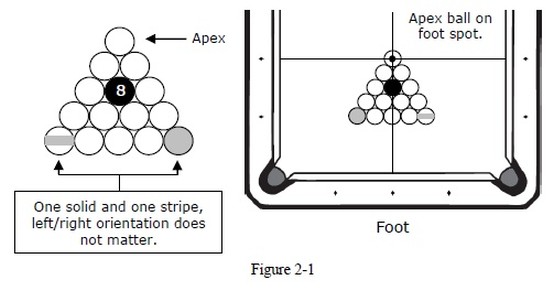Ligue de Billard de Montreal
Main menu
- Accueil
- League Info
- Emplacements
- Photos/Videos
- Documents
- Links
- Contactez Nous
- Referree Zone
8 Ball Rules
BCAPL
2-
8-
2-
The balls are racked as follows (see Figure 2-
a. in a triangle with the apex ball on the foot spot (AR p. 103);
b. the rows behind the apex are parallel to the foot string;
c. the 8-
d. the remaining balls are placed at random, except that the ball at each rear corner of the rack must be of a different group from the other rear corner (the left/right orientation those two balls does not matter). (AR p. 102)
2-
1. You begin the break with ball in hand behind the head string. The break is not a called shot, and you may not call a ball or a safety on the break. There is no requirement for the cue ball to contact any particular ball first. You must legally pocket a ball or cause at least four object balls to contact one or more cushions or it is an illegal break. If you legally pocket a ball, you continue to shoot. If you do not legally pocket a ball or you commit a foul, your inning ends. (AR p. 102)
2. If you intend to break softly, you must notify your opponent and allow them the opportunity to call a referee to watch your break. If you fail to notify your opponent you will receive a mandatory warning on the first offense. Second and subsequent offenses are fouls.
3. If your break is illegal, with or without a foul, your inning ends. Your opponent may:
a. re-
b. require you to re-
The game cannot continue until there is a legal break. If your opponent’s break is illegal and there is also a foul, the illegal break takes precedence and you must choose either option (a) or (b) above.
4. If you foul on a legal break and do not pocket the 8-
5. In all cases on the break, jumped object balls other than the 8-
2-
1. If you pocket the 8-
a. have the 8-
b. re-
2. If you pocket the 8-
a. have the 8-
b. re-
3. If the 8-
2-
The table is always open on the shot after the break and remains open until groups are established. When the table is open, all object balls except the 8-
2-
1. Groups are established when the first object ball is legally pocketed on a shot after the break. The player legally pocketing the first ball is assigned that group, and the opponent is assigned the other group. You cannot establish a group on a safety. (AR p. 102)
2. If all balls of either group are pocketed on the break or illegally pocketed before groups are established, either player may legally shoot the 8-
3. Once they are established, groups can never change for the remainder of that game. If a player shoots the wrong group and no foul is called before the next shot and the player continues to shoot at that group, or if at any time during the game it is discovered by either player or a referee that the players are shooting the wrong groups, the game will be replayed with the player who broke the game breaking again. If a game has ended and then the players realize they shot the wrong groups, the game is not replayed and the result stands.
2-
1. Once groups are established, play continues with each player having their group as legal object balls. Balls in your opponents' group and the 8-
2. Jumped object balls and illegally pocketed balls are not returned to the table but do count in favor of the player with that group.
2-
Prior to any shot except the break, you may declare a safety. On a safety, your inning ends after the shot regardless of whether you pocket any ball. If you do not declare a safety and you pocket a ball on an obvious shot, your inning continues and you must shoot again. A safety must meet the requirements of Rule 1.19, Legal Shot, or it is a foul. (AR p. 77, 103)
2-
1. The 8-
2. With the exception of the provisions of Rule 2.10, it is not loss of game if you foul when shooting the 8-
2-
You lose the game if:
a. you illegally pocket the 8-
b. you jump the 8-
c. you pocket the 8-
d. you violate any General Rule that requires loss of game as a penalty;
e. you pocket the 8-
f. you commit a foul under Rule 1-
2-
If a referee judges that the table is in a position such that any attempt to pocket or move a ball will result in loss of game on that shot, or that the game is not progressing because the position of the table has not significantly changed through three consecutive innings by each player, the referee will declare a stalemate and the game will be replayed with the player who broke the game breaking again. (AR p. 104)